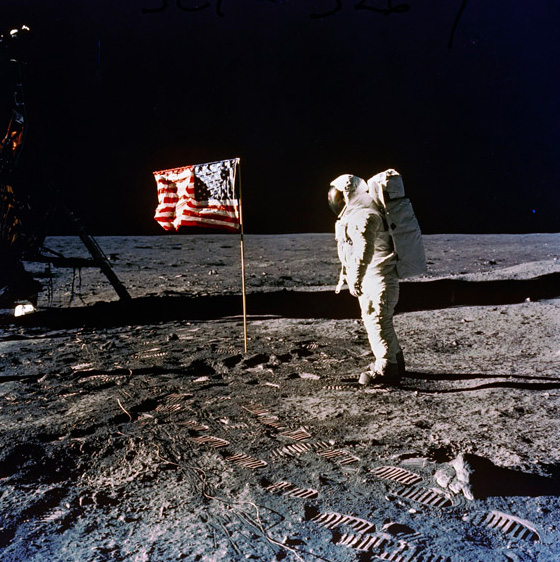The United States and the Space Race
by James Spiller
 On July 20, 1969, 650 million people witnessed an astounding event. They tuned in to live broadcasts of the first lunar landing and heard American astronaut Neil Armstrong’s famous words, “That’s one small step for man, one giant leap for mankind.” His first footstep on the Moon was a milestone in human history, and it illustrated Americans’ technological achievements and grand aspirations of that era.
On July 20, 1969, 650 million people witnessed an astounding event. They tuned in to live broadcasts of the first lunar landing and heard American astronaut Neil Armstrong’s famous words, “That’s one small step for man, one giant leap for mankind.” His first footstep on the Moon was a milestone in human history, and it illustrated Americans’ technological achievements and grand aspirations of that era.
When President John F. Kennedy called on America in 1961 to safely land a man on the Moon by decade’s end, he aimed to beat the Soviet Union in a high-stakes space race. This audacious goal smacked of science fiction and exceeded the country’s capabilities at that time. But the pace of US research and technological development (R&D) had dramatically accelerated. Seeking high-tech weapons during World War II and the Cold War as well as economy-boosting innovations, Washington invested heavily in a network of government, corporate, and university laboratories. These labs helped make the United States the scientific superpower. They spun off military and civilian innovations in aviation and rocketry, computers and communications, advanced materials and medical devices that made it the technological superpower as well. Such innovations were critical to sending people to the Moon. Just as importantly, that robust R&D network enabled the new National Aeronautics and Space Administration (NASA) to access next-generation science and technology needed for its Apollo lunar landing program. NASA contracted more than 400,000 Americans to develop the myriad technologies that delivered twelve Americans to the lunar surface by December 1972 during six Apollo missions. These costly innovations helped the US win the space race, and they spurred new industries and dazzled the world.
By doing so, NASA’s Apollo program fulfilled many aspirations. National leaders wanted to be the first to land men on the Moon (NASA did not recruit female or minority astronauts at the time). They thereby tried to win a Cold War battle for global prestige. The Soviet Union had impressed the world by beating America into space with the first satellite (Sputnik) in October 1957 and then the first cosmonaut (Yuri Gagarin) in April 1961. US leaders hoped Apollo would bolster the credibility of America’s military power, demonstrate the superiority of its democracy and capitalism, and showcase its benevolent world leadership. People around the world seemed duly impressed, and US officials hoped to draw them tightly into America’s orbit by promising greater peace and prosperity through growing partnerships in space.
The US pursued this promise in 1975 as astronauts and cosmonauts circled the planet together, and then in the twenty-first century as it partnered with Russia and several other countries on the joint International Space Station. But visionary proposals for shared expeditions back to the Moon and on to Mars did not come to pass. Instead, international space cooperation largely revolved around the Earth, particularly on satellite communications and environmental observation. Furthermore, competition in space escalated as many more countries vied to build rockets and satellites for military and commercial advantage. Seeking maximum advantage, some nations even sparked a new race to the Moon.
The US is once again in that race (primarily with China), and it plans to send multinational crews back to the Moon. Since NASA now relies on help from private spaceflight companies, which want to fly ultra-wealthy tourists there as well, this lunar race may turn out very differently. Millions were awestruck by Apollo, which showcased America’s ingenuity and Cold War leadership. It is unclear if people will be as impressed if the US returns to the Moon with diverse astronaut crews as well as some of the world’s richest paying passengers.
James Spiller is a professor of history at SUNY Brockport. He is the author of Frontiers for the American Century: Outer Space, Antarctica, and Cold War Nationalism (New York: Palgrave Macmillan, 2015). This essay was originally written in 2024 for the TLTH lesson unit “Envisioning the Moon Landing, 1901–1969” by Tim Bailey.